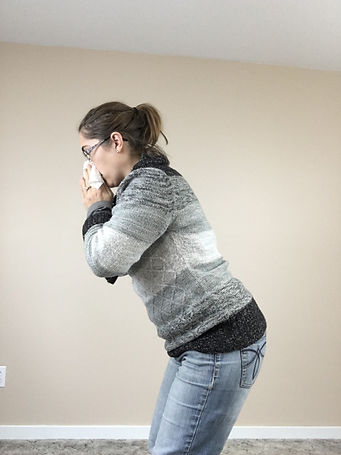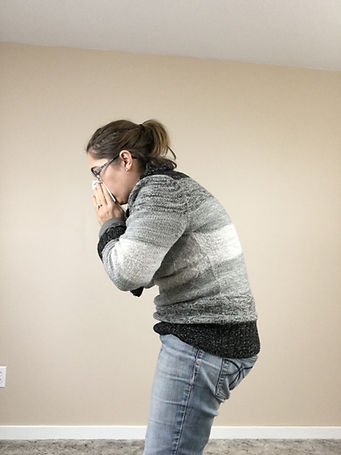Coughing, sneezing and peeing!
It's that time of year - the cold and flu season (at least it is over here in Canada).
And if you are over the other side of the world like in my home country of New Zealand where it is warm you maybe suffering from allergies - so this blog is still important for you.
If you have any pelvic floor issues or diastasis recti (or both) coughing, sneezing or blowing your nose can be really stressful.
Occasionally you may leak, embarrassing right! (even if you don't think you have pelvic floor issues this can happen!) OR you may feel like your tummy is getting ripped apart.
In this post I am going to give you a few basic tips to help you position your body in the best way to give maximum support for these unavoidable life events.

NOTE: if you have pelvic floor issues you need to address these, this doesn't replace seeing a pelvic floor PT or doing corrective exercises, ideally you should be able to sneeze without thinking, but until then use these tips
Stick your bum out
Often when we go to cough, sneeze or blow our nose we will squeeze our glutes, which in turn tucks your pelvis under.
We do this as a means to try and stabilize our pelvis.
UNFORTUNATELY when you do this it changes the angle of your pelvis and puts a lot of pressure down on the
pelvic floor. You DO NOT want this.
So when coughing, sneeze or blowing your nose I want you to think about sticking your bum OUT!

YES

NO
Get a good inhale and relax your pelvic floor
If you have pelvic floor issues (and you have time) before your cough or blow your nose I want you to think about getting a really good inhale first.
This inhale should go all the way down to your pelvic floor - you should feel it widen and relax. By doing this when you exhale to blow your nose or cough you will get an excellent contraction of your pelvic floor, stopping leaking and protecting your prolapse.
If you hold your pelvic floor tight before you cough or blow your nose it can not get a good contraction and you are more likely to leak.
Trust your body - let it do its job
Brace yourself
If you have diastasis recti, and find coughing hard on your abdomen you may want to grab a pillow to help brace yourself.
When you go to cough lean over (bum out so you hinge at the hips) and hold the pillow over your tummy, this can help take some of the pressure off when you cough.
The "ripping" feeling comes from the air being forced out of your abdomen when you cough or sneeze, so IF you have NO pelvic floor issues you may also want to try and expel all the air out of you BEFORE you cough - this means there is less pressure as it is being forced out.
Get Plenty of Rest
Most damage and set backs happen when we are tired, so if you are sick look after yourself.
Get the rest you need, and don't push yourself to do exercise if you would be better served resting.
Instead of cardio or weights take a moment to stretch or meditate. Think about your breathing and really connect with your whole core.

If you are looking for a safe and effective postnatal program that will help heal your Diastasis you should follow our FREE beginners program.
If you are ready to see changes, then check out my Total Core Solution – Belly Blast program.
This program was created with YOU in mind, as a functional core needs more than just exercise, it needs for you to reduce abdominal pressure, align your body, and strengthen your whole core.
And if your pelvis is unstable, your have hip or back pain you may want to look into my hip flexor program - this is designed to stabilze your pelvis and strengthen your surrounding muscles so your pelvis is in the optimum position to gain a strong and functional core.
Check it out now.
.png)

As always please comment below if you have any questions.
And if you found this article useful - please SHARE with others.
Katrina

